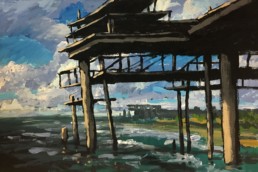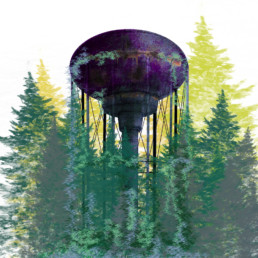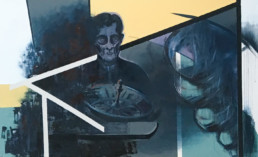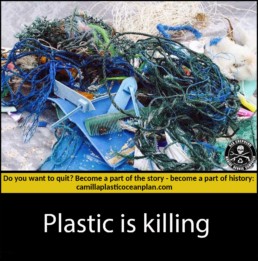The Island
Oppfinnelses ØyThe Invented Island / The Island of Inventions
Even though Øy is ‘just’ an island with various attractions, it seems to have a life of its own. Jaron has breathed life into all of his amusement rides, turning them into much more than just regular mechanical devices. Even when the park is empty, you don‘t seem to be alone. And yet, the park‘s attractions are sad. They have become rusty despite maintenance and lost their drive since Jaron left and visitors numbers started dwindling. It seems as if a dull, heavy, dark could was hovering over the island.
Listen to the audio book part 1
THE CONCEPT OF‚CAMILLA PLASTIC OCEAN PLAN‘AND SOME THOUGHTSON ARTISTIC RESEARCH
IDEA AND PROJECT MANAGEMENT Prof. Angelica Böhm
PHILOSOPHICAL PARTNER Prof. Dr. Stefan Winter
As our societies are changing rapidly, there is a growing awareness that the complex issues of the future call for new dialogues between the arts, sciences and tech development. The arts are contributing their own kinds of knowledge to the societal change. Artistic research works in its own languages and uses its own tools and procedures to question the existing and to open new perspectives. Artistic research works in its own languages and uses its own tools and procedures to question the existing and open up new perspectives. In its cooperation with science and tech development, it shows unknown horizons and brings forth new kinds of outcomes. The project Camilla Plastic Ocean Plan demonstrates this potential in its engagement with the plastic epidemic in the oceans. Focusing on the plastic epidemic in the oceans, the project demonstrates this potential.
Each year, milions of tons of plastic garbage end up in the oceans – with fatal consequences: Dolphins, whales and other marine animals die painfully after ingesting plastic bags, plastic nets and other plastic pieces. Lost fishing nets floating in the water as plastic garbage become a deadly trap for many sea dwellers. Microplastic that fish mistake for plankton and eat eventually end up in our food chain. Plastic washing ashore is contaminating our beaches and coastlines. In some maritime zones, accumulations of floating plastic debris have reached gigantic dimensions. According to the World Economic Forum, there will be more plastic in the oceans than fish by 2050.
The plastic littering of the oceans reveals an attitude towards the world in which economic and ethical dimensions intertwine. Industrial production has subdued nature, exploiting it as a source of raw material. Marx described a capitalism which requires permanent growth and progressively consumes natural resources. In many forms of modern ethics, human utility and human satisfaction have become central. The sense-giving myths of consumption are linked to the exploitation of resources: some animal species are exploited in the food industry, others lose their habitats due to environmental destruction. In both dimensions, however, a rethinking process is already underway in which the economy is discovering sustainability and ethics is questioning our dealings with animals. The narratives, imageries and visions for the future that reflect our attitude towards the world are shifting and changing.
One part of this movement is the search for concrete solutions to the problem of plastic waste and for different ways of dealing with the maritime habitat. One of the central tasks is to reduce the amount of plastic that ends up in our oceans. Here, key roles are played by the industry, which could replace plastics by other, eco-friendly materials in many products, and politics, which can pass stricter environmental regulations and already is demanding that take-back and recycling systems be set up and improved. New technologies to remove plastic from the seas are also needed. But all these concrete developments are based on a change in our views, attitudes and forms of behaviour. The artistic research in the Camilla Plastic Ocean Plan project finds a rich working field in this.
In its interdisciplinary work, the project brings artistic media into a dialogue – in VR, film and video, model making and sculpture, drawing and painting, sound design and radio play, it explores transmedia storytelling in space. In collaboration with the Alfred Wegener Institute Helmholtz Centre for Polar and Marine Research, narratives, imageries and scenarios are created. The project is further developed in an international dialogue with artists, actors from other fields of knowledge, technology developers and activists. Its starting point is the story of the Camilla Plastic Ocean Plan.
A courageous, inventive girl and her nature-loving companion tackle the challenge of plastic pollution in the oceans. On their journey they are faced with the devastating effects of the man-made material, but also experience the charms and benefits of plastics. They soon realize that preserving natural habitats requires building a global resource alliance, as well as challenging all of us to rethink our use of plastics. Using playfulness and employing artistic-creative imagination, the project explores new ways of thinking, makes utopias imaginable and generates vivid ideas of alternative paths. Camilla Plastic Ocean Plan wants to encourage people to break new ground and to blaze their own trail in the dark cosmos of infinite possibilities that have not yet been thought of. We are able to invent worlds, create visions for the coexistence of people from the most diverse backgrounds, and sketch alternative orientations in the world we live in.
Das Konzept von„Camilla Plastic Ocean Plan“und Gedanken zurkünstlerischen Forschung
IDEE UND LEITUNG Prof. Angelica Böhm
PHILOSOPHISCHE BEGLEITUNG Prof. Dr. Stefan Winter
Im schnellen Wandel unserer Gesellschaften wächst die Einsicht, dass die komplexen Zukunftsfragen neue Dialoge zwischen Künsten, Wissenschaften und Technologieentwicklung fordern. In die gesellschaftliche Transformation bringen die Künste ihre eigene Art des Wissens ein. Die künstlerische Forschung arbeitet in ihren eigenen Sprachen, und sie setzt eigene Werkzeuge und Verfahren ein, um Bestehendes zu hinterfragen und neue Perspektiven zu eröffnen. In ihrer Zusammenarbeit mit Wissenschaften und Technologieentwick-lung öffnet sie unbekannte Horizonte und lässt neuartige Ergebnisse entstehen. Das Projekt Camilla Plastic Ocean Plan zeigt dieses Potenzial in seiner Auseinandersetzung mit der Plastik-Epidemie in den Meeren.
Millionen Tonnen Plastikmüll gelangen jährlich in die Meere, mit fatalen Folgen: Delfine, Wale und andere Meerestiere sterben an den Plastiktüten, Plastiknetzen und Plastikteilen, die sie fressen. Verlorene Fischernetze, die als Plastikmüll im Wasser treiben, werden vielen Meeresbewohnern zur tödlichen Falle. Mikroplastik, das die Fische fressen, weil sie es für Plankton halten, geht in unsere Nahrungskette ein. Angetriebenes Plastik vermüllt die Strände und die Küsten. In manchen Meeresteilen bildet Plastik mittlerweile schwimmende Mülldeponien von gigantischen Ausmaßen. Das World Economic Forum erwartet, dass es 2050 in den Weltmeeren mehr Plastik als Fische geben wird.
Die Plastikvermüllung der Meere zeigt eine Haltung, in der ökonomische und ethische Aspekte ineinander greifen. Die industrielle Produktion hat sich die Natur untergeordnet und beutet sie als Rohmaterial aus. Marx beschrieb einen Kapitalismus, der ständiges Wachstum fordert und natürliche Ressourcen fortschreitend verbraucht. In vielen Formen der modernen Ethik werden der menschliche Nutzen und die menschliche Befriedigung zentral. Die sinnstiftenden Mythen des Konsums verbinden sich mit der Ausbeutung der Ressourcen: einige Tierarten werden in der Nahrungsmittelindustrie vernutzt, andere verlieren durch Umweltzerstörung ihre Lebensräume. In beiden Dimensionen setzt bereits ein Umdenken ein, in dem die Ökonomie die Nachhaltigkeit entdeckt und die Ethik unseren Umgang mit den Tieren hinterfragt. Die Erzählungen, Bildwelten und Zukunftsprojektionen, die unsere Haltung zur Welt tragen, verändern und verschieben sich.
Ein Teil dieser Bewegung ist die Suche nach konkreten Lösungswegen für das Problem des Plastikmülls und nach einem anderen Umgang mit dem maritimen Lebensraum. Eine der zentralen Aufgaben besteht darin, die Menge an Plastik zu verringern, die jährlich in die Meere gelangt. Hier ist die Industrie gefragt, die Plastik in vielen Fällen durch umweltverträgliches Material ersetzen könnte, und die Politik, die Umweltauflagen erlassen kann und bereits fordert, dass Rücknahme- und Recycling-Systeme eingerichtet und verbessert werden. Neue Technologien, mit denen das Plastik aus den Meeren wieder zu entfernen ist, kommen hinzu. Alle diese konkreten Entwicklungen gehen aber aus von einer Veränderung unserer Sichtweisen, Einstellungen und Verhaltensformen. Die künstlerische Forschung im Camilla Plastic Ocean Plan Projekt findet hier ein reiches Arbeitsfeld.
In seiner interdisziplinären Arbeit bringt das Projekt künstlerische Medien in einen Dialog – in VR, Film und Video, Modellbau und Skulptur, Zeichnung und Malerei, Sounddesign und Hörspiel erprobt es das transmediale Erzählen im Raum. In Zusammenarbeit mit dem Alfred Wegener Institut Helmholtz Zentrum für Polar- und Meeresforschung entstehen Narrative, Bilderwelten und Szenarien. Im internationalen Dialog mit Künstler*innen, Akteur*innen anderer Wissensfelder, Technologieentwickler*innen und Aktivisten wird das Projekt weiter entwickelt. Sein Ausgangspunkt ist die Geschichte vom Camilla Plastic Ocean Plan
Ein mutiges Erfindermädchen und ihr naturverbundener Begleiter stellen sich der Herausforderung des Plastikmülls in den Meeren. Auf ihrer Reise begegnen sie den schlimmen Auswirkungen des menschengemachten Materials, erliegen aber auch seinen Reizen und Vorteilen. Schnell wird klar, dass zur Rettung der maritimen Lebensräume eine globale Ressourcenallianz nötig ist sowie die Aufforderung an jeden Einzelnen, den Umgang mit Plastik zu hinterfragen. Mit spielerischen Mitteln und künstlerisch gestaltender Fantasie sucht das Projekt nach neuen Denkansätzen, macht Utopien vorstellbar und bringt eine lebendige Ahnung von anderen Wegen in die Welt. Camilla Plastic Ocean Plan möchte Mut machen, Neuland zu betreten und eine eigene Spur zu bahnen im dunklen Kosmos der unendlichen Möglichkeiten, die noch nicht gedacht wurden. Wir können Welten erfinden, Visionen für ein Miteinander von Menschen mit verschiedensten Geschichten bilden und Orientierungen in der Lebenswelt entwerfen.






























